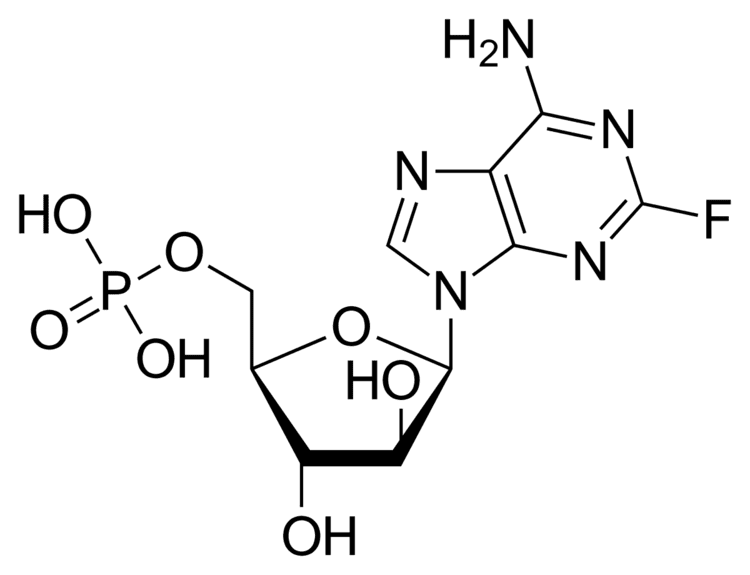Trade names Fludara, others MedlinePlus a692003 Routes ofadministration intravenous, by mouth CAS ID 75607-67-9 Bioavailability 55% | AHFS/Drugs.com Monograph Pregnancycategory D ATC code L01BB05 (WHO) Molar mass 365.212 g/mol | |
 | ||
Fludarabine, sold under the brand name Fludara among others, is a chemotherapy medication used in the treatment of leukemia and lymphoma. This include chronic lymphocytic leukemia, non-Hodgkin's lymphoma, acute myeloid leukemia, and acute lymphocytic leukemia. It is given by injection into a vein or by mouth.
Contents
Common side effects include nausea, diarrhea, fever, rash, shortness of breath, numbness, vision changes, and feeling tired. Severe side effects include brain dysfunction, low blood cell counts, and lung inflammation. Use in pregnancy will likely result in harm to the baby. Fludarabine is in the purine analog family of medications and works by interfering with the duplication of DNA.
Fludarabine was approved for medical use in the United States in 1991. It is on the World Health Organization's List of Essential Medicines, the most effective and safe medicines needed in a health system. The wholesale cost in the developing world is about 54.00 USD per 50 mg vial. In the United Kingdom it costs about 155.00 pounds per 50 mg vial.
Medical uses
Fludarabine is highly effective in the treatment of chronic lymphocytic leukemia, producing higher response rates than alkylating agents such as chlorambucil alone. Fludarabine is used in various combinations with cyclophosphamide, mitoxantrone, dexamethasone and rituximab in the treatment of indolent non-Hodgkins lymphomas. As part of the FLAG regimen, fludarabine is used together with cytarabine and granulocyte colony-stimulating factor in the treatment of acute myeloid leukaemia. Because of its immunosuppressive effects, fludarabine is also used in some conditioning regimens prior to allogeneic stem cell transplant.
Side effects
Fludarabine is associated with profound lymphopenia, and as a consequence, increases the risk of opportunistic infections significantly. Patients who have been treated with fludarabine will usually be asked to take co-trimoxazole or to use monthly nebulised pentamidine to prevent Pneumocystis jiroveci pneumonia. The profound lymphopenia caused by fludarabine renders patients susceptible to transfusion-associated graft versus host disease, an oftentimes fatal complication of blood transfusion. For this reason, all patients who have ever received fludarabine should only be given irradiated blood components.
Fludarabine causes anemia, thrombocytopenia and neutropenia, requiring regular blood count monitoring. Some patients require blood and platelet transfusion, or G-CSF injections to boost neutrophil counts.
Fludarabine is associated with the development of severe autoimmune hemolytic anemia in a proportion of patients.
Difficulties are often encountered when harvesting peripheral blood stem cells from patients previously treated with fludarabine.
Pharmacology
Fludarabine is a purine analog, and can be given both orally and intravenously. Fludarabine inhibits DNA synthesis by interfering with ribonucleotide reductase and DNA polymerase. It is active against both dividing and resting cells. Being phosphorylated, fludarabine is ionized at physiologic pH and is effectually trapped in blood. This provides some level of specificity for blood cells, both cancerous and healthy.
History
Fludarabine was produced by John Montgomery and Kathleen Hewson of the Southern Research Institute in 1968. Their previous work involved 2-fluoroadenosine, which was unsafe for use in humans; the change to this arabinose analogue was inspired by the success of vidarabine. However, in June 2016 during a clinical trial of CAR T-cell therapy, two patients died due to swelling of the brain, which occurred after fludarabine was added to the pre-conditioning chemotherapy regimen.
Names
It is generally used as its phosphate salt known as fludarabine phosphate.
